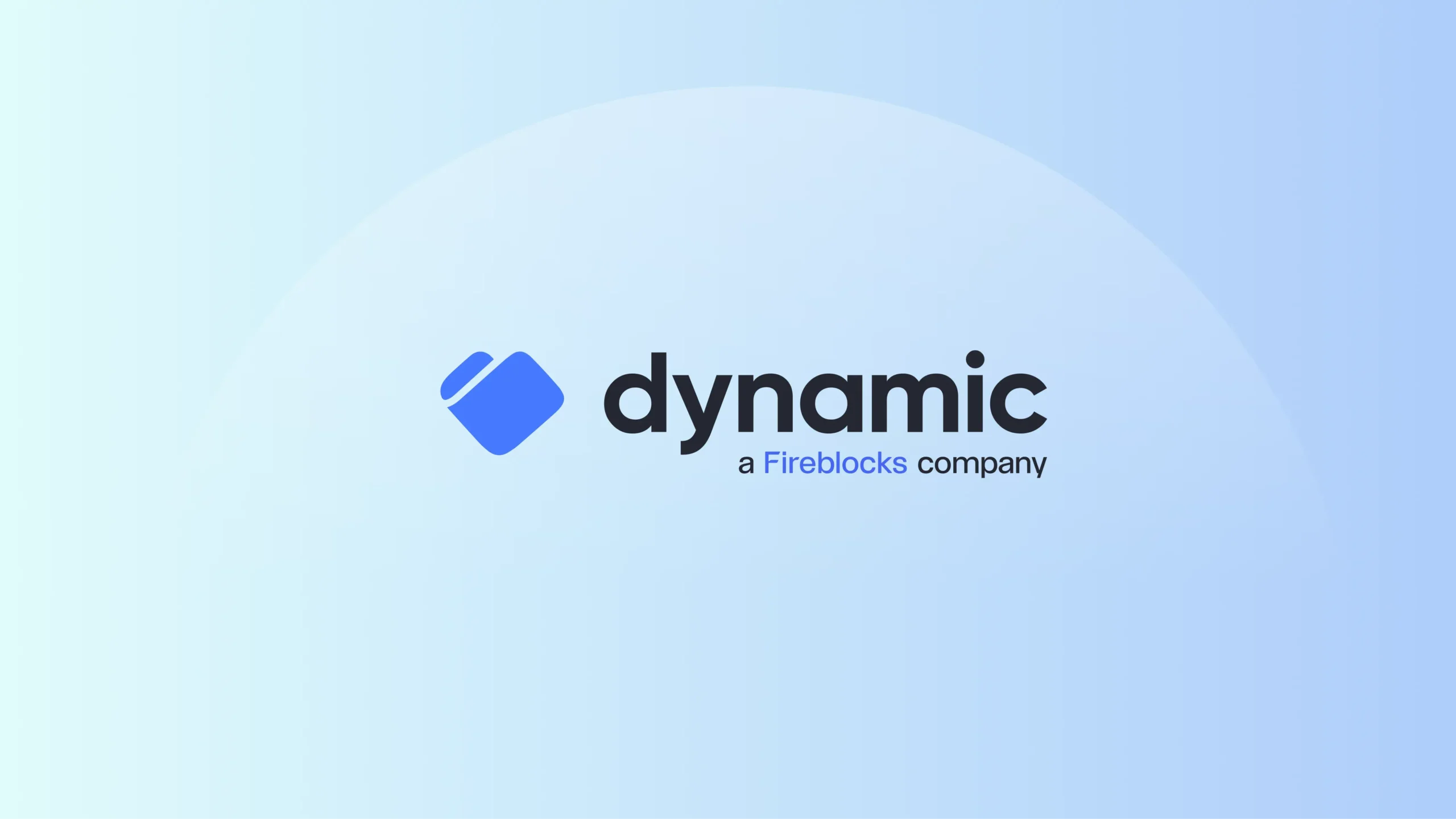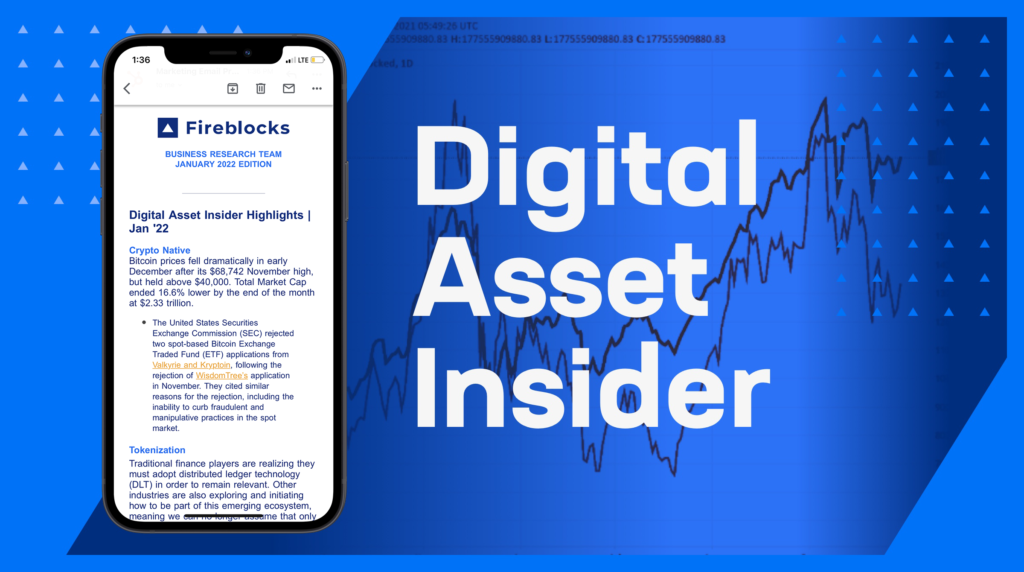The digital asset markets took a breather last month after a phenomenal rise, especially for Ethereum, which increased over 400% year-on-year. A legal firm realizing they have a specialized expertise has launched their own security tokenization platform. We are also seeing regulators setting the scene for 2022 in what the market could expect from them in the coming year. Another exciting development is the use of NFTs as collateral for loans. The new year is shaping up to be another big one for digital assets on all fronts.
Want to know what we’re expecting to see this year? Check out Fireblocks’ 7 Predictions for 2022!
Crypto Native
In early December, Bitcoin fell sharply from its November high of $68,742, but held above $40,000. Total Market Cap was 16.6% lower at $2.33 trillion by the end of the month. Year-on-year, Total Market Cap increased 205.2%, dominated by BTC (+62.7%) and ETH (+404.4%). DeFi and ETH were the big winners of 2021: Total Value Locked grew 1,239.2%, from $18.3 billion to $244.8 billion. This growth prompted the largest financial institutions across the globe to respond to their client’s increased demand for digital assets, resulting in regulators across every major jurisdiction taking concerted efforts to determine how to regulate digital assets.
- The United States Securities Exchange Commission (SEC) rejected two spot-based Bitcoin Exchange Traded Fund (ETF) applications from Valkyrie and Kryptoin, following the rejection of WisdomTree’s application in November. They cited similar reasons for the rejection, including the inability to curb fraudulent and manipulative practices in the spot market.
- Three futures-bitcoin based ETFs by Valkyrie, ProShare and VanEck were approved inside the U.S.
- Canada has launched five and Brazil has two crypto-related ETFs available for investors to gain exposure to digital assets. There are also several bitcoin backed funds in Europe in the form of ETFs and ETPs (Exchange Traded Products).
- Spot-bitcoin based ETFs from VanEck, WisdomTree, Valkyrie and Kryptoin were rejected in December
- Bitwise and Grayscale are looking to convert their spot-bitcoin based trusts to ETFs, which is currently under review by the SEC
- 2021 has seen major U.S. banks take steps to offer their wealthy clients exposure to digital assets.
- March: Morgan Stanley offered its clients exposure to bitcoin through bitcoin funds and Goldman Sachs announced it would launch products for its clients in the second quarter of the year. Meanwhile, JPMorgan looked to create a structured note with a basket of companies with exposure to digital assets such as Square, MicroStrategy, Tesla, Intercontinental Exchange, and CME Group.
- May: Wells Fargo announced it would offer managed cryptocurrency funds to its clients and Goldman Sachs would offer trading of bitcoin futures to its clients.
- August: Citibank is reported to have started trading bitcoin futures.
- October: Bank of America launched a research desk focused on digital assets.
- Traditional finance institutions that have launched or have announced plans for digital exchanges include:
- Switzerland’s SIX: SIX Digital Exchange (SDAX)
- Singapore’s DBS Bank: DBS Digital Exchange (DDEx)
- Thailand’s Stock Exchange of Thailand: Thai Digital Exchange (TDX) (Expected 3rd quarter 2022)
Tokenization
Understanding how to leverage tokenization technology will be key to accelerating its adoption in financial markets. Distributed ledger technology (DLT) is open for all to use and develop, so traditional finance players are realizing they must adopt in order to remain relevant. Other industries are also exploring and initiating how to be part of this emerging ecosystem, meaning we can no longer assume that only traditional finance firms have the potential to understand, initiate, and fund digital asset projects.
- On December 10th, Brazil Stock Exchange B3’s President Gilson Finkelsztain outlined a number of opportunities the firm is exploring in 2022, including digital asset custody, the launch of a crypto-based exchange traded fund, and tokenization of assets.
- In the first quarter of 2022, SWIFT will launch a series of experiments aimed at supporting tokenized asset market flows, including issuance, delivery versus payment (DVP), and redemption processes. SWIFT will work with traditional market participants such as Clearstream and Northern Trust, as well as blockchain payment and settlement firm SETL.
- Former United States Securities and Exchange Commission (SEC) Chair, Jay Clayton expressed his views in the Wall Street Journal for U.S. Treasuries to be tokenized in an effort to make the financial system more efficient and secure. He also urged tokenization enterprises to build products that are interoperable with the Federal Reserve, banks, investors, and consumers to enable financial inclusion.
- Law firm DLA Piper and technology provider Aldersgate DLS launched TOKO, a security token platform built using Hedera Hashgraph’s consensus algorithm and network, Hyperledger Fabric’s blockchain, and Microsoft Azure’s cloud platform. DLA Piper seeks to use their expertise to address the legal complexities involving ownership of real assets tokenized and moved around in the digital world.
Regulation | Regulators
Regulators have released numerous reports over the last quarter reviewing the emerging digital asset class and its potential impact on financial stability, financial inclusion, and future regulation requirements for this ecosystem. As expected, media headlines are pointing to the need for coordinated efforts in regulating digital assets and tracking how they are used.
- With a focus on the Australian payments system, Australian Treasurer Josh Frydenberg announced that new regulations will include digital assets and cryptocurrencies in Australia’s established set of financial regulations. Prior to this announcement, the Senate released a report on October 20th outlining their findings on the future of technology and finance as they relate to digital assets.
- The Bank of England’s Executive Director for Financial Strategy and Risk, Sarah Breenden, is reported by The Times to have shared her views on the expectation for international cooperation around the regulation of cryptocurrencies, given the need for reliable data on institutional investor holdings of digital assets. It would mean a level of cooperation is needed between central banks and financial governing bodies.
- The United States Office of the Comptroller of the Currency (OCC) is approaching crypto-related activities in the federal banking system very carefully, citing the need for sufficient expertise on products and services in the digital asset sector and sound risk management. Guidance for banks is expected to be announced in 2022.
Payments | Settlement
Distributed ledger technologies and infrastructure projects initiated by traditional finance players continue to demonstrate their potential to reduce transaction settlement times. Payment service providers have expanded their networks to allow digital assets to be used as a means of payment for goods and services between consumers and merchants. They are not waiting for regulators or large financial institutions to define the financial system’s overall ability to provide such services to their customers.
- The Bank for International Settlements successfully tested CBDCsfor cross-border payments and settlements. The project included transferring wholesale CBDCs between French and Swiss commercial banks on a single distributed ledger, as well as the issuance, transfer, and redemption of tokenized commercial paper.
- VISA is reported to have partnered with 60 crypto exchanges, enabling their clients to seamlessly convert their digital assets to fiat to pay for goods and services through the Visa payment network.
- Point-of-sales fintech firm FLEXA, which connects consumers directly to merchants via their digital payment services platform, added support for Cardano (ADA) on their network adding to their list that allows the use of Bitcoin (BTC), Bitcoin Cash (BCH), Ethereum (ETH), and Gemini Dollar (GUSD).
Decentralized Finance
Institutional investor access to permissioned decentralized finance applications is taking on one of its first major clients. Blockchain protocol platforms continue to vie for position behind Ethereum as each look for ways to increase usage of their protocols for developers.
- Fireblocks announced the launch of the first permissioned DeFi pool with Aave Arc. 30 licensed financial institutions have been approved to participate in Aave Arc as suppliers, borrowers, and liquidators with the current TLV at $10M.
- SEBA Bank is seeking to be a whitelister on permissioned DeFi platform, Aave Arc, to give their institutional clients access to DeFi yields, which provide higher interest rates than currently available in traditional markets.
- Open-source blockchain payment platform, Terra (LUNA), has reached $20 billion in Total Value Locked (TVL), placing it second behind Ethereum (TVL $159 billion) and ahead of Binance Smart Chain (TVL $17 billion). The increase in a protocol’s TVL has become a measure or indication of the protocol’s usage and its ecosystem participants.
- DeBond, a decentralized protocol for issuing bonds on Ethereum, received seed funding of $500,000, valuing the company at $12.5 million. DeBond has pioneered the development of ERC-3475 Multiple Callable Bonds token standard, which introduces features to read bonds, transfer a collection of bonds, and have bonds redeemable from the bond issuer given specific conditions. DeBond will also operate a decentralized exchange (DEX) and provide wallet infrastructure. Issuing tokenized debt has gained further attention, as more traditional finance institutions explore tokenization entry points to meet the ongoing demand for credit and yield.
Centralized Finance
Non-fungible tokens (NFTs) have grabbed the attention of many participants in the market in recent months. Centralized finance players are also enabling the use of NFTs as collateral for loans or, in the case of large holders of cryptocurrencies, identifying opportunities to leverage their balance sheets by lending out cryptocurrencies and generating income yield.
- Nexo and Fidelity Digital Assets announced a partnership in December to offer institutional access to digital assets with custodial and lending services. Nexo has also launched a non-fungible token (NFT) lending program with Three Arrows Capital, where NFTs are used as collateral to borrow cryptocurrencies like Ethereum (ETH) and stablecoins.
- Centralized exchange Kraken announced in late December that it plans to launch its own NFT platform and allow clients to use their NFTs as collateral for loans.
- MicroStrategy is looking for ways to lend out its holdings of approximately 122,500 bitcoin (valued at $6.1 billion assuming a price of $50,000 per bitcoin) to generate income.
Custody
Crypto-native firms are starting to get approval from regulators for licensing in the United Kingdom, adding to the number of regulated firms offering access to cryptocurrencies in other jurisdictions like Switzerland and Singapore. Meanwhile, traditional finance firms continue to create crypto service and product offerings for their customers to help them gain exposure to digital assets.
- Genesis Trading’s custody application under Genesis Custody Limited has received approval to provide custody services from the Financial Conduct Authority (FCA) in the United Kingdom. 24 more firms have registered with the FCA to provide custody services for digital assets.
- Spain’s BBVA Switzerland arm expanded its cryptocurrency custody and trading service to offer customers access to Ethereum (ETH) through an account named New Gen.
CBDCs
CBDC projects involving central banks and financial institutions have had mostly positive results, encouraging further moves to develop the infrastructure to support and scale CBDCs at wholesale and retail levels. Several countries see CBDCs as a way to increase financial inclusion for their citizens and, give them greater access to financial resources. It is also an opportunity to upgrade their financial system infrastructure to increase efficiency and lower transaction costs.
- The Reserve Bank of Australia has completed a two-year project exploring a wholesale CBDC under Project Atom, and found “potential for a wholesale CBDC and asset tokenization to improve efficiency, risk management and innovation in wholesale financial market transactions.” The project included financial services firm Perpetual and two of Australia’s largest banks, the Commonwealth Bank of Australia and National Bank of Australia.
- Jamaica’s central bank, Bank of Jamaica, announced the completion of its pilot CBDC and plans to roll out the digital currency in the first quarter of 2022. The country is seeking to increase financial inclusion by making it easier for citizens to make payments, as well as give domestic financial institutions the opportunity to improve cash management processes and costs.
- The central bank of Mexico, Banxico, is targeting the launch of its own CBDC for 2024 to advance financial inclusion in the country.
- The Reserve Bank of India is said to be open to a basic CBDC model that will allow users to benefit from a digital currency that is accepted, easy to transact, enables faster settlement, and is an alternative to cash. The bank will need to answer questions around the design elements of the CBDC and whether it would be used as a wholesale CBDC, retail CBDC, or both.

ESG Impact
With the emergence of tokenization technologies, specific use cases like the tokenization of carbon credits have become a reality, with digital exchanges becoming a natural trading venue for carbon credit tokens to list and attract liquidity. It also makes the tokens readily available for corporations to offset their carbon emissions and for institutional and retail investors to gain exposure to these environmentally focused assets. Standards for measuring carbon emissions generated from digital assets have been released, enabling baselines to be established for clear pathways toward stated goals.
- The Crypto Climate Accord (CCA) has released guidance for the accounting and reporting of electricity use and carbon emissions from cryptocurrency activities as part of the CCA’s commitment to achieve net-zero emissions from electricity consumption associated with crypto-related operations by 2040.
- In early December, Coinbase listed the Moss Carbon Credit (MCO2) token, leading to a high of $21.70 on launch day and settling at $9.97 by month’s end. Funds raised through token sales are used for certified environmental projects (1 MCO2 Token = 1 carbon credit from a Verra Verified Carbon Standard (VCS) certified environmental project, 1 carbon credit = 1 ton of CO2).
- Former deputy chair of the Australian Securities & Investments Commission, Daniel Crennan, has signed on to represent an Australian-based carbon credit trading platform, BetaCarbon, which issues BetaCarbon tokens (BCAU) linked to Australian Carbon Credit Units (ACCU) when green generation projects capture or reduce emissions (1 BCAU = 1 kg of ACCU = 1kg of captured carbon). BetaCarbon is exploring access to markets in New Zealand, Canada, and the United Kingdom.
Crypto-Native Market Analytics
Crypto-native markets broadly retraced from their all-time highs throughout December. DeFi alternative coins (Alt Coins) also remained weak, with the exception of Terra (LUNA) +43.1% and Polygon (MATIC) +41.4%. A few others ended slightly higher: Fantom (FTM) +5.1%, Curve Finance (CRV) +6.0% and Aave (AAVE) +5.9%.
CHART OF THE MONTH: Bitcoin Market Velocity

While BTC remains volatile, the research team’s analysis using market velocity and net position against moving average price points to market behavior aligned with what is seen in other markets when large institutions get involved — sell when prices get expensive and buy when prices get cheap. (CoinMetrics)
MONTHLY CHANGE

Most key tokens closed lower on the month, with the exception of Aave, which gained 6%, and Sushiswap, which recovered 37% on hopes of the resolution of internal conflicts plaguing the project in recent months. (Coingecko)
TOP 10 MARKET CAPITALIZATION

Terra is the talk of the town after gaining almost 48% in market cap for the month, and it became the second largest DeFi protocol after Ethereum in terms of total value locked. (Coingecko)
BITCOIN [BTC]

Price continued to weaken in December and retraced to the 23.6% fibonacci level ~$46,600. Above the September low of $39,876, the up trend technically remains. (Glassnode)
ETHEREUM [ETH]

Falling from the November all-time high, ETH retraced above the 38.2% fibonacci level, holding at around $3,500. The uptrend remained in play and would only indicate weakness below $2,700 or continued strength above $4,860. (Glassnode)
BITCOIN : STOCK TO FLOW RATIO [BTC:STFR]

BTC is lower than STFR indicating it is undervalued.
The Stock to Flow Ratio is a popular model that assumes that scarcity drives value. Stock to Flow is defined as the ratio of the current stock of a commodity (i.e. circulating Bitcoin supply) and the flow of new production (i.e. newly mined bitcoins). Bitcoin’s price has historically followed the STFR and therefore it is a model that can be used to predict future Bitcoin valuations. (Glassnode)
BTC: ALL EXCHANGES NETFLOW

Net outflows were observed for 19 days in the month as BTC continued to trade lower with large pre-Christmas net inflows observed as price gained from the monthly lows.
The difference between the number of BTC flowing into and out of all exchanges’ wallets. (If positive, inflow>outflow, an increase in BTC supply for selling, altcoins purchasing, and margin trading.) (CryptoQuant)
REGIONAL BTC FLOWS [Last 7 Day Average, Jan 3]

Regional flows over the final weeks of 2021 were predominantly intra-regional and lower than the prior 30 days, with the change in regional flows supporting this view with lower inter-regional flows observed across the board. Western Europe did see what appears to be higher intra-regional flows.
Assets typically flow within a region, likely due to preferences for local exchanges, but flows between regions often occur as a result of regulatory concerns, geopolitical changes, or significant market price variations (Chainalysis)
TOTAL VALUE LOCKED [TVL, Jan 3]

TVL fell from $270.4B to $244.9B, almost wiping the gains seen in November as ETH prices fell from the all-time high of $4,859. Defi Llama Total Value Locked (Glassnode)
DEFI PULSE INDEX [DPI]

Top 5 Tokens: Uniswap, Aave, Loopring, Maker, and Sushiswap.
Index information can be found at Tokensets.com. (Messari)
This reCap is distributed for general informational and educational purposes only and is not intended to constitute legal, tax, accounting, or investment advice. For other important disclosures.


